For most, nightfall signals the time for dinner, a bit of TV and bed, but for a few diehard anglers it’s the start of a new session chasing some the east coast’s best sport fish.
In the dark fish can throw caution to the wind and feed like it’s their last supper. This is the time to chase that trophy fish – while its guard is down.
Modern night luring has great advantages in that you don’t need to take a day off work to participate. It’s great for filling in a few spare hours while you unwind from a hard day’s work and can be as simple or as complicated as you like.
Let’s take a look at what night lure fishing entails.
Surrounding lights are the key to night lure fishing. Without them there would be no concentration of bait or fish in a particular area.
These lights can be on a breakwall, bridge, jetty, ferry crossing or a nearby building. They can be bright white or orange sodium lights, it doesn’t matter. What does matter is that they must shine on the surface of the water and preferably create shadow lines.
These shadow lines are the places from where the predatory fish ambush their prey. They use the cover of the shadow to look into the light and spot any baitfish, squid or prawn that gets swept by with the tide.
Bridges generally have great shadow lines created by the overhead lighting. These shadows are usually a metre or two out from the line of pylons and stretch the whole way across a river, thus giving the predators a variety of depths to hunt.
Bridges are usually built across the narrowest section of rivers, creating bottlenecks where fish have no option but to pass through.
Bridges are quite common around most towns, making them very accessible to most anglers.
Jetties and wharves are another great source of light – providing your local council has not banned fishing because of past experiences with grubby anglers who leave a mess of unused bait and rubbish for the morning commuters to smell or step in on their way to work!
These structures usually front deep water and can turn on some great fishing when conditions are favourable. It is a bit trickier to fish shadow lines here as because they will generally be right at your feet if you’re fishing land-based.
Some may have tall mooring poles or a tree that creates a shadow out and away from the main structure. This is where you should focus your efforts.
Now that you have an idea of what to look for, let’s examine techniques and tactics.
My main lures of choice are soft plastics because of their versatility. Fish them shallow, deep, mid-water, wherever; their potential is limited only by your imagination.
Most fish you encounter around illuminated structure hold in the bottom third of the water column, which is where you need to be presenting your lure.
There are exceptions, as always, and if the fish are boofing bait off the surface it would probably pay to change tactics and target them on the top.
Careful selection of a suitable jig head for the depth of water you are fishing is paramount. Too light and you won’t be in the zone, too heavy and you risk not making it into the strike zone and looking way too unnatural anyhow.
You need a jig weight that will get you to the bottom but is light enough to still get a natural, wafting presentation that the fish won’t be able to resist.
There are no hard and fast rules here so you will have to get out there and experiment with different head styles and tails to find the right combination for your area.
Whether you’re land based or in a boat, the tactics are the same. You want to be upstream of the shadow line so that the tide will take your offering into the shadows while you retrieve it across the line to intercept the predators.
Being upstream allows you to hold your lure in the strike zone for as long as possible to elicit a strike.
Make your cast well upstream of the shadows to allow your lure to reach the bottom before starting a hop-and-stop retrieve.
As the tide nears a change you may find it necessary to cast closer to the shadow line to get into the strike zone. Good eyesight is a prerequisite for this style of fishing because bites need to be detected visually by watching the belly in the line for any sudden flicks or taps. Strike quickly and firmly when a bite is detected.
Hard lures are used in much the same fashion but won’t need to be cast as far upstream to get into the zone. They have the great ability to be held in the shadow line against the tide and still look natural to the predators.
Species you’re likely to encounter on a night session can be varied and depend on the location.
In the salt you can expect to catch whiting, bream, flathead, estuary perch, trevally of several species depending on latitude, squid, tailor and mulloway.
In the freshwater reaches bass and estuary perch are the dominant species but can be joined by the occasional bream and flathead in the Summer in the upper tidal limits.
Most of these species take soft plastics but another great alternative is the vibe or blade.
These compact, fish-shaped metal and/or polycarbonate lures are gold at night. They sink quickly, allowing anglers a longer bite window once the tide starts to belt through, and they emit great vibrations that fish can home in on. Jewfish, with their highly developed lateral line, are especially fond of them.
Lure colour is always a highly debatable subject but at night it’s all about the silhouette.
Darker colours like pumpkinseed are favoured but there are exceptions. I have had good success with clear lures with heavy gold fleck and also with solid white lures. It pays to mix it up if what you have chosen isn’t turning a scale.
Lure shape can make a big difference to catch rates, too. It can affect the sink rate of your jig head.
Always remember that a paddletails, shads and curl-tail plastics create resistance as they fall to the bottom. You can counter this by swapping to a stickbait or slimmer profile or increasing the weight of your jig head to compensate for the slower sink rate.
Lure fishing at night might not be for everyone but if you’re time-poor or are seeking a new and exciting way to catch a few fish and maybe even hook that fish of your dreams, give night lure fishing a go.
To experience this unique style of fishing arrange a charter with me at Sydney Sportfishing Adventures on 0405 196 253 or --e-mail address hidden--
Facts
SAFETY
When lure fishing from a boat at night I am generally on the electric motor to hold position. This means that my vessel is technically under way and I am required to display navigation lights as well as the all-round white light. This is crucial because other vessels approaching will have an obstructed view of your vessel until they are clear of the structure you are fishing around.
Always be on the lookout for other vessels and be prepared to take evasive action should they not see you.
Don’t anchor in channels, especially the designated channel under a bridge.
Remember, too, that all occupants aboard any boat under 4.8m must wear a lifejacket between dusk and dawn.
Dress sensibly. Even in Summer it can get cool after dark, especially if it’s windy. Keeping warm and dry is the best way to stay comfortable and alert.
LED head lamps, including those that mount on caps, are inexpensive and a great help when rigging up and tying on lures. – DS
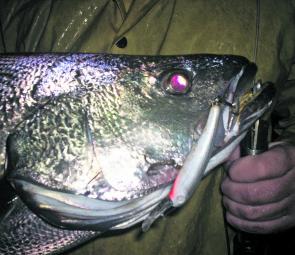
Jewfish are prized targets at night. This fish took a Mann’s Stretch 10+ trolled across the shadow line of a bridge on a wet and windy night.

Estuary perch love to feed around lights at night. Small crankbaits like this RMG Scorpion are great when the fish are boofing on the surface.
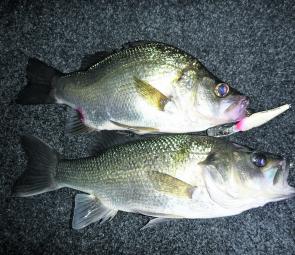
Bass on a plastic and an EP on a hardbody. Different species feed together under the cover of darkness. It can be hard to work out a pattern when they hit everything cast their way!

Bass like this 540mm beast cab drop their guard after dark.
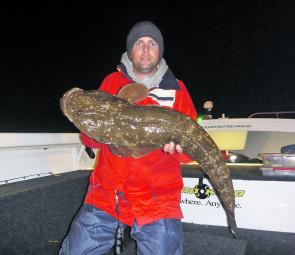
Croc-sized flathead use the shadow lines as ambush stations. Make sure your lure passes through this zone to get results like this.

Bream aren’t the most common species after dark but when they do turn up they are usually crackers like this 49cm bluenose.
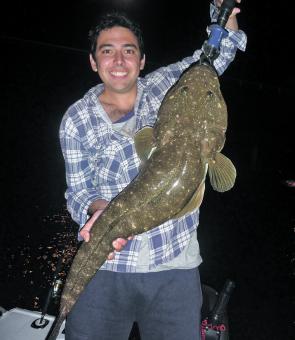
Boat positioning is fundamental to getting the right retrieve. For this fish the author anchored up-current and well above the shadow line.
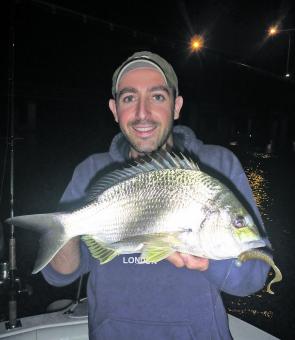
Paulie Romano with a solid 39cm Bream. Note the 9g jig head and Squidgy Wriggler tail, perfect for getting into the zone when the tide is pushing hard.
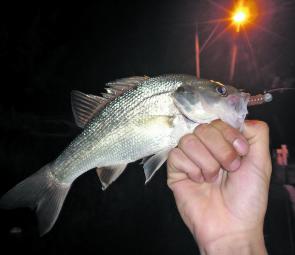
Sodium lights and a plucky bass. Wharves, bridges, pontoons, boat ramps and buildings can provide the all-important mix of light and shadows.




